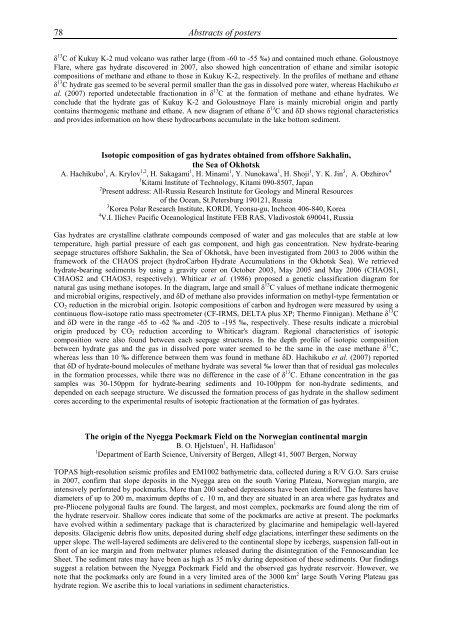Ninth international conference on - Marum
Ninth international conference on - Marum
Ninth international conference on - Marum
Create successful ePaper yourself
Turn your PDF publications into a flip-book with our unique Google optimized e-Paper software.
78<br />
Abstracts of posters<br />
δ 13 C of Kukuy K-2 mud volcano was rather large (from -60 to -55 ‰) and c<strong>on</strong>tained much ethane. Goloustnoye<br />
Flare, where gas hydrate discovered in 2007, also showed high c<strong>on</strong>centrati<strong>on</strong> of ethane and similar isotopic<br />
compositi<strong>on</strong>s of methane and ethane to those in Kukuy K-2, respectively. In the profiles of methane and ethane<br />
δ 13 C hydrate gas seemed to be several permil smaller than the gas in dissolved pore water, whereas Hachikubo et<br />
al. (2007) reported undetectable fracti<strong>on</strong>ati<strong>on</strong> in δ 13 C at the formati<strong>on</strong> of methane and ethane hydrates. We<br />
c<strong>on</strong>clude that the hydrate gas of Kukuy K-2 and Goloustnoye Flare is mainly microbial origin and partly<br />
c<strong>on</strong>tains thermogenic methane and ethane. A new diagram of ethane δ 13 C and δD shows regi<strong>on</strong>al characteristics<br />
and provides informati<strong>on</strong> <strong>on</strong> how these hydrocarb<strong>on</strong>s accumulate in the lake bottom sediment.<br />
Isotopic compositi<strong>on</strong> of gas hydrates obtained from offshore Sakhalin,<br />
the Sea of Okhotsk<br />
A. Hachikubo 1 , A. Krylov 1,2 , H. Sakagami 1 , H. Minami 1 , Y. Nunokawa 1 , H. Shoji 1 , Y. K. Jin 3 , A. Obzhirov 4<br />
1 Kitami Institute of Technology, Kitami 090-8507, Japan<br />
2 Present address: All-Russia Research Institute for Geology and Mineral Resources<br />
of the Ocean, St.Petersburg 190121, Russia<br />
3 Korea Polar Research Institute, KORDI, Ye<strong>on</strong>su-gu, Inche<strong>on</strong> 406-840, Korea<br />
4 V.I. Ilíchev Pacific Oceanological Institute FEB RAS, Vladivostok 690041, Russia<br />
Gas hydrates are crystalline clathrate compounds composed of water and gas molecules that are stable at low<br />
temperature, high partial pressure of each gas comp<strong>on</strong>ent, and high gas c<strong>on</strong>centrati<strong>on</strong>. New hydrate-bearing<br />
seepage structures offshore Sakhalin, the Sea of Okhotsk, have been investigated from 2003 to 2006 within the<br />
framework of the CHAOS project (hydroCarb<strong>on</strong> Hydrate Accumulati<strong>on</strong>s in the Okhotsk Sea). We retrieved<br />
hydrate-bearing sediments by using a gravity corer <strong>on</strong> October 2003, May 2005 and May 2006 (CHAOS1,<br />
CHAOS2 and CHAOS3, respectively). Whiticar et al. (1986) proposed a genetic classificati<strong>on</strong> diagram for<br />
natural gas using methane isotopes. In the diagram, large and small δ 13 C values of methane indicate thermogenic<br />
and microbial origins, respectively, and δD of methane also provides informati<strong>on</strong> <strong>on</strong> methyl-type fermentati<strong>on</strong> or<br />
CO2 reducti<strong>on</strong> in the microbial origin. Isotopic compositi<strong>on</strong>s of carb<strong>on</strong> and hydrogen were measured by using a<br />
c<strong>on</strong>tinuous flow-isotope ratio mass spectrometer (CF-IRMS, DELTA plus XP; Thermo Finnigan). Methane δ 13 C<br />
and δD were in the range -65 to -62 ‰ and -205 to -195 ‰, respectively. These results indicate a microbial<br />
origin produced by CO2 reducti<strong>on</strong> according to Whiticar's diagram. Regi<strong>on</strong>al characteristics of isotopic<br />
compositi<strong>on</strong> were also found between each seepage structures. In the depth profile of isotopic compositi<strong>on</strong><br />
between hydrate gas and the gas in dissolved pore water seemed to be the same in the case methane δ 13 C,<br />
whereas less than 10 ‰ difference between them was found in methane δD. Hachikubo et al. (2007) reported<br />
that δD of hydrate-bound molecules of methane hydrate was several ‰ lower than that of residual gas molecules<br />
in the formati<strong>on</strong> processes, while there was no difference in the case of δ 13 C. Ethane c<strong>on</strong>centrati<strong>on</strong> in the gas<br />
samples was 30-150ppm for hydrate-bearing sediments and 10-100ppm for n<strong>on</strong>-hydrate sediments, and<br />
depended <strong>on</strong> each seepage structure. We discussed the formati<strong>on</strong> process of gas hydrate in the shallow sediment<br />
cores according to the experimental results of isotopic fracti<strong>on</strong>ati<strong>on</strong> at the formati<strong>on</strong> of gas hydrates.<br />
The origin of the Nyegga Pockmark Field <strong>on</strong> the Norwegian c<strong>on</strong>tinental margin<br />
B. O. Hjelstuen 1 , H. Haflidas<strong>on</strong> 1<br />
1 Department of Earth Science, University of Bergen, Allegt 41, 5007 Bergen, Norway<br />
TOPAS high-resoluti<strong>on</strong> seismic profiles and EM1002 bathymetric data, collected during a R/V G.O. Sars cruise<br />
in 2007, c<strong>on</strong>firm that slope deposits in the Nyegga area <strong>on</strong> the south Vøring Plateau, Norwegian margin, are<br />
intensively perforated by pockmarks. More than 200 seabed depressi<strong>on</strong>s have been identified. The features have<br />
diameters of up to 200 m, maximum depths of c. 10 m, and they are situated in an area where gas hydrates and<br />
pre-Pliocene polyg<strong>on</strong>al faults are found. The largest, and most complex, pockmarks are found al<strong>on</strong>g the rim of<br />
the hydrate reservoir. Shallow cores indicate that some of the pockmarks are active at present. The pockmarks<br />
have evolved within a sedimentary package that is characterized by glacimarine and hemipelagic well-layered<br />
deposits. Glacigenic debris flow units, deposited during shelf edge glaciati<strong>on</strong>s, interfinger these sediments <strong>on</strong> the<br />
upper slope. The well-layered sediments are delivered to the c<strong>on</strong>tinental slope by icebergs, suspensi<strong>on</strong> fall-out in<br />
fr<strong>on</strong>t of an ice margin and from meltwater plumes released during the disintegrati<strong>on</strong> of the Fennoscandian Ice<br />
Sheet. The sediment rates may have been as high as 35 m/ky during depositi<strong>on</strong> of these sediments. Our findings<br />
suggest a relati<strong>on</strong> between the Nyegga Pockmark Field and the observed gas hydrate reservoir. However, we<br />
note that the pockmarks <strong>on</strong>ly are found in a very limited area of the 3000 km 2 large South Vøring Plateau gas<br />
hydrate regi<strong>on</strong>. We ascribe this to local variati<strong>on</strong>s in sediment characteristics.














